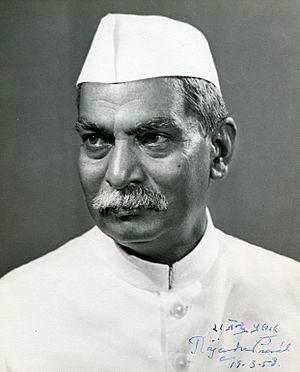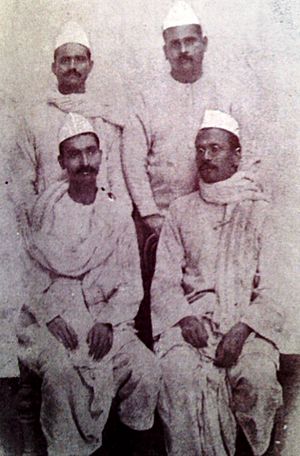Rajendra Prasad facts for kids
Quick facts for kids
Rajendra Prasad
|
|
|---|---|
 |
|
| 1st President of India | |
| In office 26 January 1950 – 13 May 1962 |
|
| Prime Minister | Jawaharlal Nehru |
| Vice President | Sarvepalli Radhakrishnan |
| Preceded by | Position established |
| Succeeded by | Sarvepalli Radhakrishnan |
| 1st Minister of Agriculture | |
| In office 15 August 1947 – 14 January 1948 |
|
| Prime Minister | Jawaharlal Nehru |
| Preceded by | Position established |
| Succeeded by | Jairamdas Daulatram |
| President of Constituent Assembly of India | |
| In office 9 December 1946 – 24 January 1950 |
|
| Prime Minister | Jawaharlal Nehru |
| Vice President | Harendra Coomar Mookerjee V. T. Krishnamachari |
| Preceded by | Sachchidananda Sinha |
| Succeeded by | Position abolished |
| Personal details | |
| Born | 3 December 1884 Ziradei, Bengal Presidency, British India (present-day Bihar, India) |
| Died | 28 February 1963 (aged 78) Patna, Bihar, India |
| Political party | Indian National Congress |
| Spouse | Rajvanshi Devi |
| Children | Mrityunjay Prasad |
| Alma mater | University of Calcutta |
| Awards | Bharat Ratna (1962) |
Rajendra Prasad (born December 3, 1884 – died February 28, 1963) was an important Indian leader. He was a lawyer, a journalist, and a scholar. Most importantly, he was the first President of India, serving from 1950 to 1962.
He joined the Indian National Congress during the movement to free India from British rule. He became a key leader from the regions of Bihar and Maharashtra. Rajendra Prasad was a strong supporter of Mahatma Gandhi. The British government put him in jail during important protests like the Salt Satyagraha in 1931 and the Quit India movement in 1942.
After elections in 1946, Prasad became the Minister of Food and Agriculture. When India became independent in 1947, he was chosen as the President of the Constituent Assembly of India. This group wrote the Constitution of India and acted as India's first temporary Parliament.
When India became a republic in 1950, Rajendra Prasad was elected as its first President. As President, he made sure the office was fair and independent, stepping away from party politics. Even though his role was mostly ceremonial, he encouraged education in India. He also gave advice to the government led by Prime Minister Nehru many times. In 1957, he was re-elected, making him the only President to serve two full terms. He held office for about 12 years, the longest term for an Indian President.
Contents
Early Life and Family
Rajendra Prasad was born into a family in Ziradei, a village in the Siwan district of Bihar. This was during the time when India was ruled by the British Raj. His father, Mahadev Sahai Srivastava, was a very smart person who knew both Sanskrit and Persian. His mother, Kamleshwari Devi, was a religious woman. She often told him stories from famous Indian epics like the Ramayana and Mahabharata.
Rajendra Prasad was the youngest of his siblings. He had one older brother and three older sisters. Sadly, his mother passed away when he was a child. After that, his elder sister helped take care of him.
Student Days and Learning
After finishing his early education at home, Rajendra Prasad went to the Chapra District School. In June 1896, when he was just 12 years old, he got married to Rajavanshi Devi. He and his older brother, Mahendra Prasad, then went to study at T.K. Ghosh's Academy in Patna for two years.
He did very well in his studies. He came first in the entrance exam for the University of Calcutta and received a scholarship of 30 rupees each month. In 1902, Prasad joined the Presidency College, Calcutta to study science. He graduated with top marks in 1905. An examiner was so impressed by his answers that they wrote, "examinee is better than examiner" on his paper.
Later, he decided to study arts and earned his Master's degree in Economics from the University of Calcutta in 1907. He lived with his brother at the Eden Hindu Hostel. Rajendra Prasad was not just a dedicated student; he was also active in public life. He was a member of The Dawn Society, which focused on education.
He helped start the Bihari Students Conference in 1906 in Patna. This was the first group of its kind in India. It helped produce important leaders from Bihar, such as Anugrah Narayan Sinha and Krishna Singh. These leaders played a big part in later freedom movements.
His Career Path
As a Teacher
After getting his Master's degree in economics, Rajendra Prasad became an English professor at the Langat Singh College in Muzaffarpur, Bihar. He even became the principal of the college. However, he later left teaching to study law. He joined the Ripon College, Calcutta (now called the Surendranath Law College). While studying law in Kolkata in 1909, he also taught economics at Calcutta City College.
As a Lawyer
In 1915, Rajendra Prasad took the Master's in Law exam from the Department of Law, University of Calcutta and won a gold medal. He also earned a Doctorate in Law from Allahabad University. In 1916, he started working at the High Court of Bihar and Odisha. He was also one of the first members of the Senate of Patna University in 1917. He practiced law in Bhagalpur, a famous silk town in Bihar.

Role in India's Freedom Movement
Rajendra Prasad played a very important role in India's fight for freedom. He first got involved with the Indian National Congress in 1906 as a volunteer. He officially joined the Congress party in 1911.
In 1916, he met Mahatma Gandhi at a Congress meeting. During a visit to Champaran, Gandhi asked Prasad and his volunteers to help. Prasad was deeply inspired by Gandhi's dedication and courage. When the Non-Cooperation Movement was approved by the Congress in 1920, he gave up his successful law career and his university duties to join the movement.
He also supported Gandhi's call to boycott Western schools. He asked his own son, Mrityunjaya Prasad, to leave his studies and join Bihar Vidyapeeth. This was an institution that Prasad and his friends started based on traditional Indian learning.
During the freedom movement, he met Mahapandit Rahul Sankrityayan, a famous writer. Sankrityayan was very impressed by Prasad's intelligence and saw him as a guide. Prasad wrote articles for revolutionary newspapers like Searchlight and Desh. He also collected money for these papers. He traveled widely, explaining the ideas of the independence movement to people.
He actively helped people when floods hit Bihar and Bengal in 1914. When a big earthquake struck Bihar on January 15, 1934, Prasad was in jail. He asked his friend Anugrah Narayan Sinha to manage the relief work. He was released two days later and quickly set up the Bihar Central Relief Committee. He worked hard to raise money to help those affected. After another earthquake in Quetta in 1935, he was not allowed to leave the country. So, he set up the Quetta Central Relief Committee in Sindh and Punjab and led it from afar.
He was chosen as the President of the Indian National Congress in October 1934. He became president again in 1939 after Subhash Chandra Bose resigned. On August 8, 1942, the Congress passed the Quit India Resolution. This led to many Indian leaders being arrested. Prasad was arrested in Patna and sent to Bankipur Central Jail. He stayed in jail for almost three years and was released on June 15, 1945.
After the Interim Government was formed in September 1946, led by Jawaharlal Nehru, Prasad was given the Food and Agriculture department. He was elected as the President of the Constituent Assembly on December 11, 1946. He became Congress President for a third time in November 1947.
Becoming President of India

Two and a half years after India gained independence, on January 26, 1950, the Constitution of independent India was approved. On that day, Rajendra Prasad was elected as the first President of India. Sadly, his sister Bhagwati Devi passed away the night before Republic Day. He arranged her cremation after returning from the Republic Day parade.
As President, Rajendra Prasad followed the rules of the Constitution and stayed independent of any political party. He traveled around the world as India's ambassador, building good relationships with other countries. He was re-elected for two more terms in 1952 and 1957. He is the only President of India to have served two full terms.
During his time as President, the beautiful Mughal Gardens at the Rashtrapati Bhavan (the President's official home) were opened to the public for about a month each year. This has become a popular tradition for people visiting Delhi.
Prasad acted independently from politics, just as the Constitution expected of the President. After a disagreement about a law called the Hindu Code Bill, he took a more active role in state matters. In 1962, after serving 12 years as President, he decided to retire.
After leaving office in May 1962, he returned to Patna and chose to live at the Bihar Vidyapeeth campus. His wife passed away in September 1962. Later that year, he was honored with the Bharat Ratna, which is India's highest civilian award.
Rajendra Prasad passed away on February 28, 1963, at the age of 78. There is a museum in Patna called Rajendra Smriti Sangrahalaya dedicated to him.
See also
 In Spanish: Rajendra Prasad para niños
In Spanish: Rajendra Prasad para niños
- Shri Krishna Singh (politician)
- Anugrah Narayan Sinha
- Jawaharlal Nehru
- Sarvepalli Radhakrishnan
- List of politicians from Bihar


